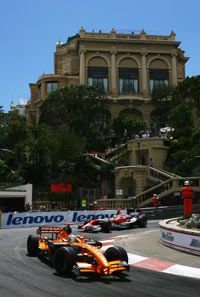Formula One Transmissions and Aerodynamics
Transmission
It's the job of the transmission to transfer all of the engine's power to the rear wheels of the Formula One car. The transmission bolts directly to the back of the engine and includes all of the parts you would expect to find in a road car -- gearbox, differential and driveshaft. The gearbox must have a minimum of four forward gears and a maximum of seven gears. Six-speed gearboxes were popular for several years, but most Formula One cars now run seven-speed units. A reverse gear must also be fitted. The gearbox is connected to a differential, a set of gears allowing the rear wheels to revolve at different speeds during cornering. And the differential is connected to the driveshaft, which transfers power to the wheels.
Shifting gears in a Formula One car is not the same as shifting gears in a road car with a manual transmission. Instead of using a traditional "H" gate selector, drivers select gears using paddles located just behind the steering wheel. Downshifting is done on one side of the steering wheel, upshifting on the other. Although fully automatic transmission systems, including systems with sophisticated launch control, are possible on Formula One cars, they are now illegal. This helps reduce the overall cost of the power train and enables drivers to use gear-shifting skills to gain advantage in a race.
Advertisement
Aerodynamics
A Formula One race car is defined as much by its aerodynamics as it is by its powerful engine. That's because any vehicle traveling at high speed must be able to do two things well: reduce air resistance and increase downforce. Formula One cars are low and wide to decrease air resistance. Wings, a diffuser, end plates and barge boards increase downforce. Let's look at each of these in greater detail.
- Wings, which first appeared in the 1960s, operate on the same principles as airplane wings, only in reverse. Airplane wings create lift, but the wings on a Formula One car produce downforce, which holds the car onto the track, especially during cornering. The angle of both front and rear wings can be fine-tuned and adjusted to get the ideal balance between air resistance and downforce.
- Lotus engineers discovered in the 1970s that a Formula One car itself could be turned into a giant wing. Using a unique undercarriage design, they were able to extract air from beneath the car, creating an area of low pressure that sucked the entire vehicle downward. These so-called "ground-effect" forces were soon outlawed and strict regulations put in place to govern undercarriage design. The bottom of today's cars must be flat from the nose cone to the rear axle line. Beyond that line, engineers have free reign. Most incorporate a diffuser, an upward-sweeping device located just beneath the engine and gearbox that creates a suction effect as it funnels air up and passes it to the rear of the car.
- Much of aerodynamics is concerned with getting air to move where you want it to move. Endplates are small, flanged areas at the edges of the front wings that help "grab" the air and direct it along the side of the car. The barge boards, located just behind the front wheels, pick up the air from there, accelerating it to create even more downforce.
The result of all this aerodynamics engineering is a combined downforce of about 2,500 kilograms (5,512 pounds). That's more than four times the weight of the car itself.
Next, we'll learn about Formula One suspensions, brakes, steering and tires.
